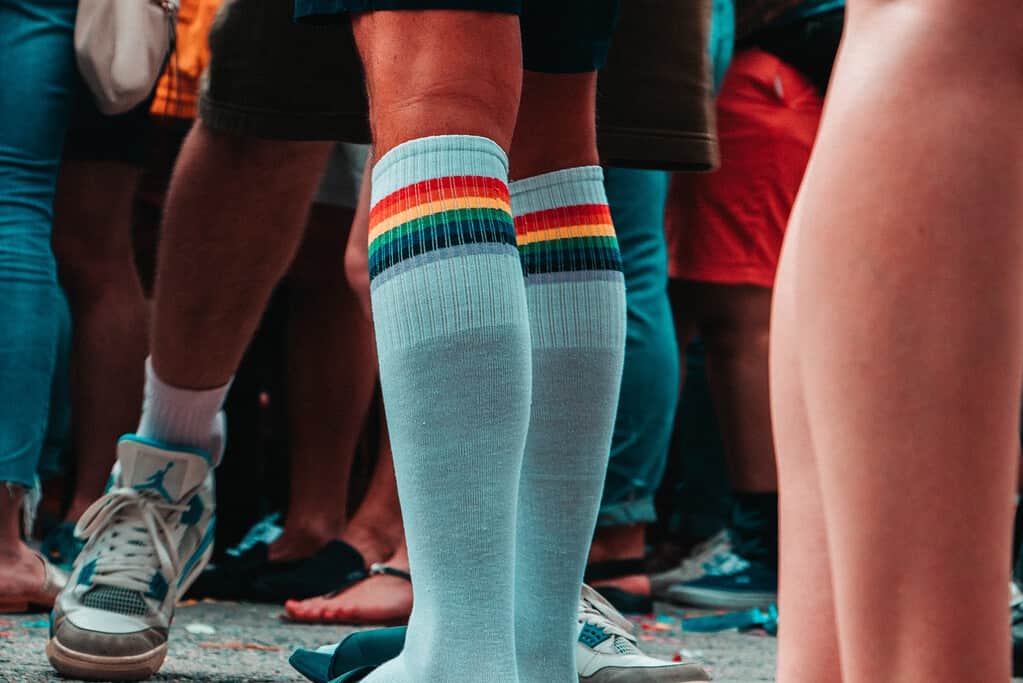
Compression socks have been getting a lot of attention in the realm of everyday health and athletic performance — seemingly coming out of nowhere.
Until not that long ago, these snug-fitting, stretchy socks have made a remarkable leap into the wardrobes of athletes, travelers, and office workers alike. But what exactly makes these socks more than just a tight-fit accessory?
Compression socks are designed to apply gentle pressure to your legs and ankles. This, in turn, is meant to promote blood circulation from your legs to your heart. They come in various sizes, styles, and compression levels. The basic principle behind these socks is to create a ‘gradient’ of compression, typically tighter around the ankles and gradually lessening towards the knees or thighs.
Believe it or not, these socks don’t have a long history — and they weren’t initially used to boost athletic performance.
Historically, the use of compression therapy has roots in treating deep vein thrombosis (DVT), a condition where blood clots form in deep veins, usually in the legs. By improving blood flow, compression socks reduce the risk of clots. Over time, the benefits of compression garments extended beyond medical use, gaining traction among athletes and fitness enthusiasts for perceived improvements in performance and recovery.
But unlike many other hype accessories, compression socks actually have some serious science behind them.
Compression socks studies
In one study, researchers conducted an experiment involving twelve well-trained male runners. Each participant completed two sessions: one wearing compression socks and the other without. The sessions included a warm-up, a 5 km time trial (TT1), a one-hour recovery, and then a repeat of the warm-up and time trial (TT2). The focus was on comparing performances between the two trials and sessions.
The compression socks didn’t affect immediate running performance. However, when it came to subsequent performance, a significant benefit was observed. Runners wearing compression socks showed less decline in performance in the second time trial compared to when they ran without the socks.
“Wearing compression socks between repeated running bouts can aid recovery and subsequent performance. Furthermore, subsequent exercise performance may be even further enhanced when athletes believe in the efficacy of compression socks to assist in recovery between exercise bouts,” the researchers note in the study.
Another study that focused on marathon runners also showed that wearing compression socks for 48 hours after a marathon improved functional recovery. In fact, the link between compression socks and recovery time has been made in various studies.
Do they also help with performance?
The link between compression socks and athletic performance is less clear. However, one notable research mentions that in moderately trained runners, compression socks made a small but significant improvement in overall performance.
“In this study, we clearly demonstrated the benefit of compressive stockings on running performance in moderately trained men runners 25-60 years old. Most interestingly, constant compression over the calf muscle affected running performance at various metabolic stages,” the study authors note.
However, the study had one important limitation: it was not nonblind. In other words, participants knew that they were wearing compression socks and this was the aim of the study — and this could have granted them extra motivation. It’s also less clear if the benefits would be carried for athletes in other sports or athletes of other levels of proficiency.
Non-sports benefits
Even if you’re not physically active (although you should be), compression socks may be useful in some instances. Here are just some of them:
- Prevention of Venous Disorders: For individuals who stand or sit for long periods, compression socks can be a boon. They help prevent the onset of venous disorders like varicose veins and spider veins by aiding blood flow.
- Travel Comfort: Long-haul travelers are often advised to wear compression socks to mitigate the risk of DVT due to prolonged immobility during flights.
- Pregnancy-Related Swelling: Pregnant women often experience swelling in the legs and feet. Compression socks can alleviate discomfort by reducing edema and improving circulation.
- Diabetic Foot Care: For those with diabetes, these socks can help manage swelling and reduce the risk of foot ulcers by improving blood flow and keeping feet dry.
Many users report a significant improvement in comfort and a reduction in leg fatigue and swelling and may simply find them comfortable.
In the end, whether you’re running a marathon, boarding a long flight, or just enduring a long day at the office, compression socks offer a simple, yet scientifically grounded solution to ensure comfort and promote health. It’s a small change to your wardrobe with potentially significant benefits for your well-being.






